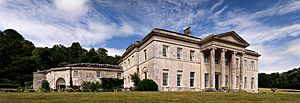Philipps House facts for kids
Philipps House is a beautiful country house in Dinton, England. It was built in 1816 in a style inspired by ancient Greek architecture, known as Neo-Grecian. The house looks out over the Nadder valley and is located about 8 miles (13 km) west of the city of Salisbury.
Originally, the house was called Dinton House. It was built for a man named William Wyndham and designed by the famous architect Sir Jeffry Wyatville. In 1916, a new owner, Bertram Philipps, bought the property and renamed the house after his own family. Later, in 1943, he generously gave the house and its large park to the National Trust, an organization that protects historic places in Britain.
Today, Philipps House is a special historic building, listed as Grade II*. Its park, called Dinton Park, is also listed for its historic importance.
Contents
Designing a Grand Home
Philipps House is made from Chilmark stone, a local limestone that was also used to build the famous Salisbury Cathedral. The architect, Jeffry Wyatville, may have gotten his inspiration from another nearby house called Pythouse.
The house has two floors and a symmetrical, balanced design. The main entrance on the south side has nine large windows and a grand porch with Ionic columns, which are known for the scroll shapes at the top.
Inside, the rooms are arranged around a large, square main hall. A special kind of staircase, called an imperial staircase, sweeps up to the first floor. Philipps House was also very modern for its time. It was one of the first houses in England to have a central heating system. This system worked by pumping warm air from a boiler in the basement up into the main stairwell, which then spread through the house.
The History of the House
The Wyndham Family
The house was designed by Jeffry Wyatville for William Wyndham. It was built between 1814 and 1817. It replaced an older house from the 1600s that was torn down. The Wyndham family had lived on this land since 1689. The house was passed down through the Wyndham family for many years. In 1916, it was sold.
A New Owner and a New Name
In 1917, the estate was purchased by Bertram Erasmus Philipps. He was a descendant of a noble family and decided to rename the house from Dinton House to Philipps House. In 1923, he served as the High Sheriff of Wiltshire, an important ceremonial role in the county.
Mr. and Mrs. Philipps did not have any children, but they were known for their kindness to the local community. Every year, they invited all the students from the village school to a party at the house, which included games, food, and fireworks.
The House During and After the War
In 1936, Mr. Philipps leased the house to the YWCA (Young Women's Christian Association) and moved to a smaller home nearby. During World War II, the park in front of Philipps House was used by the United States Army Air Force. They set up several temporary buildings, called Nissen huts, on the grounds.
In 1943, Bertram Philipps made a generous gift. He gave Philipps House, its parkland, his other home, and a collection of family paintings to the National Trust. This ensured that the historic property would be protected for the future.
The National Trust Years
When the National Trust took over, they agreed to let the YWCA continue using the house for a very low rent. For many years, the YWCA used Philipps House as a retreat for artists. They offered art courses for painters of all skill levels. The beautiful rooms were turned into art studios, and guests could stay overnight. The lovely grounds were a perfect place for painting landscapes.
The YWCA stayed at Philipps House until 1995. The art courses were still very popular, but the YWCA had to leave because the lease agreement changed. The new lease required the YWCA to pay for major repairs to the building, which was too expensive for them.
After the YWCA left, the National Trust repaired and updated the house. It was then leased to a private family. As of 2025, the house itself is not open to the public. However, the beautiful parkland around it, still known as Dinton Park, is open for everyone to enjoy.



